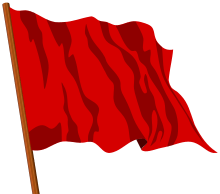Awami National Party
 Peace, Democracy, and Development | |
| Leader |
Afrasiab Khattak Bushra Gohar Mian Iftikhar Haider Hoti |
| President | Asfandyar Wali Khan |
| General Secretary | Mian Iftikhar Hussain |
| Founder | Abdul Wali Khan |
| Founded | 1986 |
| Split from | National Awami Party |
| Headquarters | Baacha Khan Markaz Peshawar, Pakistan |
| Student wing | Pakhtun Students Federation |
| Youth wing | National Youth Organization |
| Ideology |
Democratic socialism Pashtun nationalism[1] Secularism Historical: • Marxism |
| Political position | Centre-left[2] to Left-wing |
| Colors |
Red |
| Senate |
6 / 104 |
| National Assembly |
2 / 342 |
| Khyber Pakhtunkhwa Assembly |
5 / 124 |
| Balochistan Assembly |
1 / 65 |
| Election symbol | |
| red cap | |
| Party flag | |
 | |
| Website | |
| Awami National Party | |
The Awami National Party (Pashto: ملي عوامي ګوند, Urdu: عوامی نيشنل پارٹی; Acronym: ANP), is a secular and a leftist Pashtun political party in Pakistan.[3] The party was founded by Abdul Wali Khan in 1986 and its current president is Asfandyar Wali Khan, grandson of Bacha Khan, with Tajuddin Khan serving as the Secretary-General. Part of the PPP-led cabinet of the Pakistani government during 2008-13, the ANP's political position is considered left wing, advocating for secularism, democratic socialism, public sector government, and economic egalitarianism.[4]
ANP was the largest Pashtun nationalist party in Pakistan between 2008-2013 with influence lying in the Pashtun dominated areas in and around Khyber-Pakhtunkhwa. Although given a chance to govern from 2008–13, they proved unpopular amongst the ethnic Pashtun they claimed to represent, and the party's fortunes turned rapidly as they lost almost all of their seats in 2013 to Imran Khan's PTI.
History
Khan Abdul Wali Khan's political career had been built on the tradition of intense Pashtun nationalism inherited from his father, Khan Abdul Ghaffar Khan (Bacha Khan). Although it was formed after the partition of India but most of the leaders were Pro-India, and were against the creation of Pakistan. Most of the leaders were used to congress right hands before the independence. Both men were opposed to the creation of Pakistan, and after the proclamation of independence of Pakistan in 1947, they were imprisoned. In 1956 Wali Khan joined the National Awami Party (NAP), led by a charismatic Bengali socialist, Abdul Hamid Khan Bhashani. In 1965 the NAP split into two factions, with Wali Khan becoming president of the pro-Moscow faction.[5] The party's members participated in 1970 parliamentary elections through the Pakistan Peoples Party's platform and the National Awami Party, forming a largest socialist alliance with Zulfikar Ali Bhutto in 1970. However, the alliance fell apart and its members joined the Pakistan National Alliance.
In 1972 the party was strong enough to form coalition provincial governments, with its partner the Jamiat Ulema-e-Islam (JUI) in Khyber Pakhtunkhwa and Balochistan. These governments were short lived. Wali Khan was again jailed, and his party was barred from politics when the Supreme Court upheld the finding of President Bhutto that the NAP was conspiring against the state of Pakistan. General Zia-ul-Haq subsequently withdrew the charges against the NAP. Wali Khan was released, joined the National Democratic Party, and ultimately formed the Awami National Party. In the meantime, President Bhutto was imprisoned and executed in April 1979.[5]
Formation and struggle for democracy
The Awami National Party (awami means "people's"), which depends on ethnic Pashtuns (Pukhtuns) of Khyber Pakhtunkhwa (formerly NWFP) and northern Balochistan as its political base, was formed in 1986 by the merger of several left-leaning parties including the Awami Tehrik and the National Democratic Party.[5]
The National Democratic Party merged with several other progressive political and nationalist groups to form the Awami National Party. Wali Khan, the influential Pashtun and Soviet-backed leader, was elected as its first president and Sindhi socialist Rasul Bux Palejo was appointed its first secretary general. From 1986 to 1988, the ANP party was a member of the Movement for Restoration of Democracy.
Alliance with Pakistan Peoples Party (PPP)
Since its inception, the ANP has been an important ally of the Pakistan Peoples Party (PPP). The party formed a coalition government with the PPP in Khyber-Pakhtunkhwa, and in Sindh province and Islamabad for central government after the Pakistani parliamentary elections in 1988. This alliance, however, collapsed in April 1989 after differences cropped up between the two parties, after Prime Minister Benazir Bhutto ordered a military action that brutally failed. The Awami National Party later formed an alliance with the Pakistan Muslim League (PML) in early June 1989 which led to a formal split in the party with many activists allying with the PPP.
After the election of Nawaz Sharif in 1990, the ANP again formed a coalition with former rivals PML. This alliance proved longer lasting, surviving till 1998 when it collapsed over differences over the building of Kalabagh Dam and renaming the province NWFP to Pakhtunkhwa. It won six seats in the National Assembly in the 1990 elections. In the 1993 national elections, the party won three seats in the National Assembly.[5] It then joined the Grand Democratic Alliance, campaigning against the Sharif government's policies. After Nawaz Sharif's overthrow by Pervez Musharraf, the party stayed an active member of the Alliance for Restoration of Democracy, until the 2001 September 11 attacks in the United States, when it left the alliance over supporting NATO's ouster of the Taliban government. The party's reputation was damaged in this period following the arrest of former Federal Minister and senior party leader Azam Khan Hoti.[6]
In the 2002 elections the party struck up an alliance with the PPP. However, both parties were electorally routed in Khyber Pakhtunkhwa by the religion-political alliance Muttahida Majlis-e-Amal (MMA) riding on a wave of anti-American sentiment in Pakistan.[7]
In the 2008 parliamentary elections, the ANP dominated the far-right wing coalition, the MMA, a party formed by coalition of Islamic movements in 2002. The ANP has also won provincial seats in Balochistan and in Sindh for the first time in 15 years. It formed a coalition government with the Pakistan People's Party in all three provinces. In Khyber Pakhtunkhwa, the ANP has its first chief minister since 1948.
The strongholds of the ANP are in the Pashtun dominated areas of Pakistan, particularly in the Mardan area of Khyber Pakhtunkhwa, while the city of Karachi in Sindh province hosts one of the largest Pashtun populations in the world. The ANP has traditionally dominated Charsadda, Mardan, Nowshera, Peshawar, and Swabi areas of central KPK. Of the 168 seats in Sindh Assembly, MQM, representing the Muhajir population, has 50 seats while the ANP, representing the Pashtun population, has only 2 seats. "Based on demographics, the Pasthuns of Karachi could have up to 25 seats in the provincial assembly, but they have only two."[8] Pashtuns began migrating to Karachi after the creation of Pakistan in 1947 and are now the city's second largest ethnic group after the Muhajirs, a people who originally came in large numbers from India after 1947 and settled in Karachi.[9] With as high as 7 million by some estimates, the city of Karachi in Pakistan has the largest concentration of urban Pakhtun population in the world, including 50,000 registered Afghan refugees in the city.[10]
Recent events
In May 2008, Asfandyar Wali Khan made an unannounced visit to the United States in which he and his delegate held high-level meetings with top U.S. officials.[11] A source explained that "the delegation is here as part of a visitors programme that brings important people from other nations for meeting US civil and military officials and members of the civic society." This was Wali Khan's second such visit to the United States, a country where he has several relatives.[11]
To most Pakistanis they are known, but Pakistani media called the people behind the unrest in Karachi, Sindh unknown. The MQM has been accused by almost all political parties of using far left procedure to disturb peace in stable cities of Pakistan, and to forcefully pressure the government to accept its ideology and agenda. The MQM party is accused by all political parties of instigating violence in Sindh as renegades.[12]
In the last decade, thousands of members of the ANP have been assassinated or became victims of target killings.[12][13] Most of the attacks occurred in the Karachi and Peshawar areas.[14][15] An ANP rally in Quetta was subject to a bomb blast on 13 July 2012. The blast killed six people and injured 12 others. It was speculated that a cycle parked behind the stage was the probable cause. The dead included two children as well.[16]
| General elections | Voting percentile % | Voting turnout | Seating graph | Presiding chair of the party | Parliamentary position |
|---|---|---|---|---|---|
| 1988 | 2.1% | 409,555 | 2 / 207 | Abdul Ghaffar Khan | In alliance with PPP |
| 1990 | 1.7%% | 356,160 | 6 / 207 | Abdul Ghaffar Khan | In Opposition |
| 1993 | 1.7% | 335,094 | 3 / 207 | Abdul Vali Khan | Remain in Neutrality |
| 1997 | 1.9% | 357,002 | 10 / 207 | Abdul Val Khan | In Opposition |
| 2002 | 1.0% | – | 0 / 272 | Abdul Vali Khan | — |
| 2008 | 2.0% | 700,479 | 10 / 272 | Asfandyar Vali | In alliance with PPP |
| 2013 | TBD | TBD | 1 / 272 | Asfandyar Vali | In Opposition |
Ideology

The party espouses a nonviolent approach to tackling extremism.[4] It promotes democratic socialism, secularism, economic egalitarianism, and Pashtun nationalism. The party has dense support among the Pashtun population in the country. Since 2000, its liberal socialism and pro-Pashtun philosophy has become the integral part of the party, advocating for the regional autonomy and increased Pashtun cultural expression. A frequent coalition partner in provincial politics, it was routed in the 2002 elections because of its opposition to the Taliban and support for the NATO-backed Karzai administration in neighboring Afghanistan.
It joined the opposition All Parties Democratic Movement, and along with other parties except the Pakistan Peoples Party resigned from Parliament in October 2007 in protest against the military regime of Pervez Musharraf. It was targeted in 2007 and 2008 by presumed supporters of the Taliban.[17][18] Despite the attacks, the party has advocated dialogue with moderate tribal elements to end the violence in the Government of Khyber Pakhtunkhwa and Federally Administered Tribal Areas. It has rejected foreign interference in the region. Since the 2008 elections the party has been the principal target of Tehrik-i-Taliban Pakistan (TTP) with over 100 activists having been assassinated by suicide bombers or in target killings.[19] It has also accused the Pakistani establishment of being complicit in allowing the growth of the TTP in Pakistan because of its former support for the fighters.
Foreign policy
The Awami National Party has close ties with the Pashtun dominated government of Afghanistan and with the United States. Some claim that the party also has supporters in Russia but this is difficult to verify.[20] Others claim that like its partner the Pakistan Peoples Party (PPP), the ANP suffered from the great purge by the General Zia-ul-Haq government.[21]
During the 1980s, the party demanded the end of the US-Pakistan Operation Cyclone and acceptance of Afghanistan's terms for speedy repatriation.[20] In 1987, according to calculations completed by the Pakistan Institute of Public Opinions (PIPO), around 66% of ANP's respondents expressed themselves against Pakistan's continuing support of the mujahideen fighters.[20] The mujahideen were men from over 40 Islamic nations that arrived in Pakistan in the 1980s to be used as fighters in the Soviet war in Afghanistan. This violated article 2 of the 1893 Durand Line Agreement with Kabul. The ANP party played a major role in improving Pakistan's relations with Russia.[21]
ANP leaders
The Awami National Party is one of the few parties in Pakistan to hold a system of regular internal general elections every four-year period.
- Presidents
- 1986-1990 Abdul Wali Khan
- 1991-1999 Ajmal Khattak
- 1999-2002 Asfandyar Wali
- 2002-2003 Ehsan Wyne
- 2003- 2007 Asfandyar Wali
- 2007- 2011 Asfandyar Wali
- 2011–present Asfandyar Wali Khan
- Others
- Afzal Khan Lala
- Ghulam Ahmad Bilour
- Afrasiab Khattak, Provincial President ANP Khyber-Pakhtunkhwa
- Shahi Sayed, Provincial President ANP Sindh
- Bashir Ahmad Bilour
- Ameer Haider Khan Hoti
- Abdul Nabi Bangash
- Baaz Mohammad Khan
- Muhammad Umar
- Bushra Gohar
- Haji Muhammad Adeel
- Qazi Anwar
- Mian Iftikhar Hussain
- Zahid Khan
- Irshad Khan Chagharzai
- Younas Bunairee
- Parviz Khan Safi
See also
References
- ↑ "Awami National Party - Pashtun party seeks national role". rfi.com. 29 April 2013. Retrieved 5 August 2014.
- ↑ "Elections in Pakistan". 20 February 2008. Retrieved 5 August 2014.
- ↑ "Pakistan". The World Factbook. Central Intelligence Agency.
- 1 2 "Pakistan's 'Gandhi' party takes on Taliban, Al Qaeda". Christian Science Monitor. May 5, 2008. Retrieved 2008-05-09.
- 1 2 3 4 "Pakistan:A Country Study" (PDF). Library of Congress (U.S.). April 1994.
- ↑ Waseem Ahmad Shah (29 September 2001) Govt-ANP deal seen behind Hoti's release.Issue : 07/39. DAWN Archived May 16, 2011, at the Wayback Machine.
- ↑ Pakistan on the Brink: Politics, Economics, and Society, by Craig Baxter Published by Lexington Books, 2004. ISBN 0-7391-0498-5, ISBN 978-0-7391-0498-9
- ↑ "Demographic divide". Zia Ur Rehman, a journalist and a researcher based in Karachi. thefridaytimes. July 15–21, 2011. Retrieved 2013-01-05.
- ↑ Sharmeen Obaid-Chinoy (2009-07-17). "Karachi's Invisible Enemy". PBS. Retrieved 2010-08-24.
- ↑ "UN body, police baffled by minister's threat against Afghan refugees". Dawn Media Group. 2009-02-10. Retrieved 2012-01-24.
- 1 2 "US silent on visit of Asfandyar". The Dawn News, May 10, 2008 Saturday. May 10, 2008. Retrieved 10 November 2015.
- 1 2 Shaheryar Popalza; Atika Rehman; Gibran Ashraf (July 9, 2011). "Karachi violence, over 100 dead". The Tribune Express. Retrieved 11 March 2012.
- ↑ Ahmed, Maqbool; Khan, Mansoor (March 27, 2015). "Troubled north-west comes to town". Herald - Dawn.
- ↑ Correspondent, Our. (2013-01-06) Ambushed: Police, ANP leader come under attack – The Express Tribune. Tribune.com.pk. Retrieved on 2013-08-03.
- ↑ "Nine, including senior minister, killed in Pakistan suicide blast". Times Of India. December 12, 2012.
- ↑ "Blast at ANP rally in Quetta: death toll rises to eight". Dawn. July 13, 2012.
- ↑ "ANP MNA hands over resignation". Dawn. September 27, 2007.
- ↑ "Secularists Face Tests In Northwest Pakistan". Washington Post. March 1, 2008.
- ↑ Kheshgi, Khalid (February 14, 2009). "ANP major victim of insurgency". The News.
- 1 2 3 Najom, Neamatollah (2002). The rise of the Taliban in Afghanistan§ Pakistan's leftists and the Soviets. New York, United States: Palgrave Macmillan. pp. 39;41–74. ISBN 0-312-29402-6.
- 1 2 Wirsing, Robert G. (1991). Pakistan's Security under Zia: 1977-1988§ The interventionists imperatives. U.S. (NYC): Palgrave Macmillan. p. 203. ISBN 0-312-06067-X.
External links
- Awami National Party Official Site
- Baacha Khan Trust
- Bacha Khan Research Center
- Education Foundation

